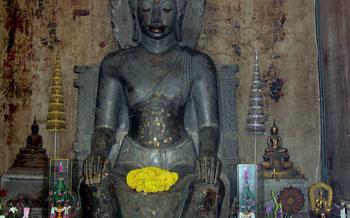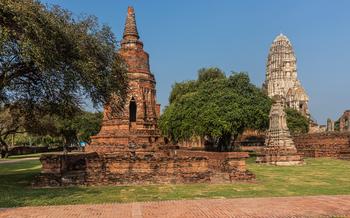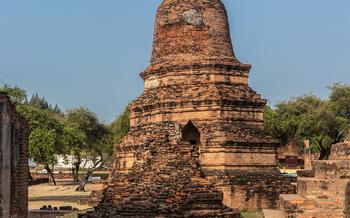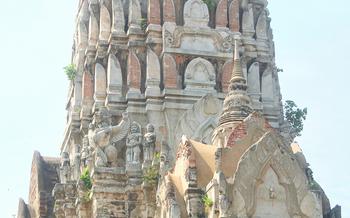
Wat Sutthawat
- The Wat Sutthawat Temple: A Stunning Spiritual Haven
- The Dazzling White Ubosot: A Centerpiece of Tranquility
- Exploring the Temple Grounds: A Journey of Discovery
- The Grand Stupa: A Symbol of Enlightenment
- The Revered Buddha Images: Objects of Devotion
- Seeking Blessings and Guidance: A Spiritual Experience
- Festivals and Celebrations: A Time for Joy and Unity
- Learning from the Monks: A Glimpse into Monastic Life
- Giving Back: Supporting the Temple and Local Community
- Finding Inner Peace: A Place for Meditation and Reflection
- Capturing the Beauty: Photography and Art at Wat Sutthawat
- Exploring the Surrounding Area: Hidden Gems and Local Delights
- Practical Information: Planning Your Visit
- Insider Tip: Unveiling the Secret Garden
The Wat Sutthawat Temple: A Stunning Spiritual Haven
Nestled in the heart of Udon Thani, Thailand, lies a hidden gem that beckons travelers seeking serenity and spiritual enlightenment: the Wat Sutthawat Temple. Built in 1984 by local devotees, this magnificent temple showcases a unique blend of modern architecture and traditional Thai artistry, creating a sanctuary that inspires awe and devotion.
The Wat Sutthawat Temple holds immense significance for the local community, serving as a center for religious practices, meditation, and spiritual guidance. Its serene atmosphere, exquisite architecture, and revered Buddha images attract both devout Buddhists and curious visitors from around the world.
As you approach the temple grounds, you'll be greeted by a sense of tranquility that envelops your senses. The lush gardens, adorned with vibrant flowers and towering trees, create a peaceful oasis that invites you to leave behind your worries and embrace the serenity of the temple.
The Dazzling White Ubosot: A Centerpiece of Tranquility
Within the sacred grounds of Wat Sutthawat, the dazzling white Ubosot stands as a testament to the beauty and serenity of Buddhist architecture. This central hall serves as the primary sanctuary for religious ceremonies and rituals, exuding an aura of tranquility that invites spiritual contemplation.
The Ubosot's exterior captivates with its pristine white walls, adorned with intricate carvings and bas-reliefs that depict scenes from Buddhist mythology. The roof, a graceful fusion of curves and spires, elevates the structure, creating a sense of awe and wonder.
Step inside the Ubosot, and you'll be greeted by a symphony of colors and artistry. The walls are adorned with exquisite murals, painted by skilled artisans, showcasing scenes from the life of Buddha, tales of Jataka, and stories of Buddhist cosmology. Each mural is a masterpiece, narrating tales of compassion, wisdom, and enlightenment.
These murals are not mere decorations; they serve as visual representations of Buddhist teachings, reminding visitors of the principles of karma, rebirth, and the path to Nirvana. The intricate details and vibrant colors captivate the senses, creating a mesmerizing experience that transports visitors to another realm.
The Ubosot is more than just an architectural marvel; it is a sacred space where Buddhist ceremonies and rituals take place. Ordination ceremonies, where young men enter the monastic order, are held within these hallowed walls, marking a significant milestone in their spiritual journey.
During these ceremonies, the air fills with the melodious chanting of monks, the rhythmic sound of gongs, and the sweet fragrance of incense. The Ubosot transforms into a stage where the cycle of life and spiritual transformation unfolds, leaving an indelible mark on the hearts of all who witness it.
Exploring the Temple Grounds: A Journey of Discovery
Surrounding the resplendent structures of Wat Sutthawat lies a world of natural beauty and spiritual serenity. Verdant gardens, adorned with vibrant flora and manicured lawns, invite visitors to wander and contemplate. The grounds are a sanctuary of tranquility, where the gentle rustling of leaves and the chirping of birds create a soothing symphony of nature.
Amongst the lush greenery, visitors will encounter an array of statues and sculptures, each depicting significant figures from Thai mythology and Buddhism. These intricate works of art, crafted with precision and devotion, tell stories of ancient legends and teachings, bringing the rich history of Thailand to life.
Hidden corners and secluded spots are scattered throughout the temple grounds, offering visitors a chance to find solace and contemplation. These quiet retreats, nestled amidst the tranquil gardens, provide the perfect setting for introspection and meditation, allowing visitors to connect with their inner selves and find spiritual rejuvenation.
The Grand Stupa: A Symbol of Enlightenment
At the heart of Wat Sutthawat stands a magnificent stupa, a towering symbol of Buddhist enlightenment and spiritual transcendence. This grand structure, known as the Phra That Sutthawat, holds immense significance in Thai culture and is a focal point of reverence for devotees.
The stupa's history is deeply intertwined with the temple's origins. It was constructed in 1958 by the revered abbot, Luang Pu Suttho, as a symbol of his unwavering faith and dedication to Buddhism. The stupa's design is a testament to the abbot's profound understanding of Buddhist teachings and his desire to create a sacred space that would inspire spiritual growth and reflection.
Architecturally, the stupa is a masterpiece of Buddhist art and architecture. Its towering white spire, adorned with intricate gold leaf patterns, reaches towards the heavens, symbolizing the path to enlightenment. The stupa's base is encircled by a series of smaller stupas, representing the various stages of the Buddha's journey towards enlightenment.
The grand stupa is not merely an architectural marvel; it is also a place of profound spiritual significance. For Buddhists, the stupa represents the Buddha's final resting place and is a reminder of his teachings on the impermanence of all things. It is believed that circumambulating the stupa, or walking around it in a clockwise direction, brings merit and purifies the mind and body.
Within the stupa, visitors will find a small chamber that houses a relic of the Buddha. This relic, believed to be a fragment of the Buddha's bone, is a sacred object of immense reverence for Buddhists. The presence of the relic adds to the stupa's spiritual significance and makes it a place of pilgrimage for devotees from near and far.
Whether you are a Buddhist pilgrim or simply a curious traveler, the grand stupa at Wat Sutthawat is a must-see attraction. Its stunning architecture, rich symbolism, and spiritual significance make it a truly awe-inspiring sight.
The Revered Buddha Images: Objects of Devotion
The Wat Sutthawat Temple houses a collection of revered Buddha images that hold immense significance for the local community and visitors alike. These images, crafted with intricate detail and embodying the essence of compassion and serenity, serve as objects of devotion and inspiration for those seeking spiritual guidance and blessings.
Among the most notable Buddha images at the temple is the Phra Phuttha Sutthawat, a majestic golden statue that resides within the Ubosot. This awe-inspiring image, adorned with intricate carvings and precious gemstones, represents the pinnacle of Buddhist art and craftsmanship. Devotees flock to the temple to pay homage to the Phra Phuttha Sutthawat, seeking blessings and expressing their unwavering faith.
Other Buddha images at the temple include the Phra Phuttha Nimit, a serene white marble statue exuding an aura of tranquility, and the Phra Phuttha Mongkhon, a bronze statue believed to possess miraculous powers. Each of these images has its unique story and significance, attracting visitors from far and wide who come to seek blessings, offer prayers, and find solace in the presence of these sacred representations of the Buddha.
In Thai culture, Buddha images are revered as symbols of the Buddha's teachings and are believed to embody his presence. Devotees often make offerings of flowers, candles, and incense to the Buddha images as a way of showing their gratitude and seeking blessings. The presence of these revered images at the Wat Sutthawat Temple creates a palpable sense of devotion and spirituality, making it a sanctuary for those seeking inner peace and spiritual fulfillment.
Seeking Blessings and Guidance: A Spiritual Experience
Wat Sutthawat is not just a place of worship; it is also a center for spiritual guidance and blessings. Devotees from all walks of life flock to the temple to seek blessings, make merit, and receive guidance from the resident monks.
One of the most common ways to seek blessings at the temple is to offer prayers and make offerings to the Buddha images. Devotees light incense sticks, offer flowers, and recite sacred mantras as a way of showing their devotion and gratitude.
For those seeking more personalized guidance, the monks at Wat Sutthawat are available to offer advice and blessings. Visitors can approach the monks, who are usually seated in the temple's meditation hall, and ask for their guidance on various matters, such as personal problems, career choices, or spiritual development.
The monks may offer words of wisdom, share stories from the Buddha's teachings, or perform a simple blessing ceremony. They may also give amulets or sacred objects to devotees as a symbol of protection and good luck.
The blessing ceremonies at Wat Sutthawat are an important part of the temple's spiritual offerings. They provide visitors with an opportunity to connect with the monks, receive guidance, and seek blessings for their lives.
Festivals and Celebrations: A Time for Joy and Unity
Wat Sutthawat comes alive during festivals and celebrations, which are vibrant expressions of Thai culture and Buddhist traditions. The temple's annual Loi Krathong and Yi Peng festival, held in November, is a sight to behold. During this festival, locals and visitors gather to release beautifully decorated floating lanterns into the sky and place lotus-shaped krathongs adorned with flowers, candles, and incense onto the temple's pond. The night sky is illuminated with a myriad of twinkling lights, creating a magical and enchanting atmosphere. Other significant festivals celebrated at the temple include Songkran, the Thai New Year in April, and Visakha Puja, which commemorates the birth, enlightenment, and passing of the Buddha in May. These festivals offer visitors a unique opportunity to immerse themselves in Thai culture, witness traditional ceremonies, and experience the warmth and hospitality of the local community.
Learning from the Monks: A Glimpse into Monastic Life
The monks at Wat Sutthawat lead a life of devotion and simplicity, dedicated to the teachings of Buddha. Their daily routine revolves around prayer, meditation, and community service. Visitors to the temple have the opportunity to engage with the monks, learn about their way of life, and gain insights into the principles of Buddhism.
Respectful interaction with the monks is essential. Visitors should observe the temple's etiquette, such as bowing to show respect, maintaining silence in sacred areas, and refraining from touching the monks. Observing the monks' daily activities, such as chanting, meditation, and alms-giving, offers a unique glimpse into the monastic lifestyle.
The monks at Wat Sutthawat are knowledgeable and compassionate, and they welcome the opportunity to share their teachings with visitors. They may offer blessings, guidance, or answer questions about Buddhism. Visitors are encouraged to ask questions and engage in respectful dialogue with the monks, fostering a deeper understanding of the Buddhist faith.
Giving Back: Supporting the Temple and Local Community
Wat Sutthawat, like many temples in Thailand, relies on donations from visitors and the local community for its upkeep and development. These donations play a crucial role in preserving the temple's architectural beauty, maintaining its serene surroundings, and supporting the monks' daily needs.
Visitors can contribute to the temple's well-being in various ways. One common practice is to make a monetary donation, which can be placed in donation boxes located throughout the temple grounds. These donations are used for various purposes, including temple maintenance, renovation projects, and the purchase of necessary supplies.
Another way to give back is to donate food or other essential items to the temple. Many temples have a designated area where visitors can leave their offerings, which are then distributed to the monks and the local community. These donations can include rice, cooking oil, canned goods, and other non-perishable items.
Supporting the temple also extends beyond monetary and material donations. Visitors can contribute their time and skills by volunteering for various temple activities. This could involve helping with cleaning and maintenance tasks, assisting with temple events and festivals, or teaching English to the young monks.
By giving back to Wat Sutthawat, visitors not only contribute to the preservation of this sacred site but also support the local community. The temple plays a vital role in providing education, social welfare, and spiritual guidance to the people of Udon Thani. Donations and volunteer efforts help ensure that the temple can continue to fulfill its mission and serve as a source of inspiration and support for generations to come.
Finding Inner Peace: A Place for Meditation and Reflection
Amidst the hustle and bustle of modern life, Wat Sutthawat offers a sanctuary for those seeking inner peace and tranquility. The temple's serene atmosphere, lush gardens, and designated meditation areas create an ideal environment for mindfulness practices. Visitors can find solace in the tranquil surroundings, away from the distractions of everyday life.
Meditation is a central practice in Buddhism, and Wat Sutthawat provides ample opportunities for visitors to engage in this transformative practice. Whether you are a seasoned meditator or a beginner seeking guidance, the temple's serene setting and knowledgeable monks can help you embark on a journey of self-discovery and inner peace.
Designated meditation areas within the temple grounds offer a tranquil space for visitors to focus on their practice. These areas are often adorned with serene Buddha images, calming water features, and lush greenery, creating a conducive environment for mindfulness and reflection.
The monks at Wat Sutthawat are also available to provide guidance and support to those interested in learning more about meditation and Buddhist teachings. Through meditation sessions, workshops, and personal interactions, visitors can gain insights into the principles and practices of meditation, fostering a deeper connection with themselves and the world around them.
Whether you are seeking a moment of respite from the demands of daily life or embarking on a transformative journey of self-discovery, Wat Sutthawat offers a sanctuary for finding inner peace and tranquility. Embrace the temple's serene atmosphere, engage in meditation practices, and discover the profound benefits of mindfulness and reflection.
Capturing the Beauty: Photography and Art at Wat Sutthawat
The Wat Sutthawat Temple presents a captivating canvas for photography and artistic expression. The temple's visually stunning architecture, intricate details, and serene surroundings make it a photographer's paradise. Whether you're a professional photographer or simply enjoy capturing beautiful moments, Wat Sutthawat offers ample opportunities to unleash your creativity.
The temple's gleaming white Ubosot, with its intricate murals and elegant lines, provides a striking subject for photography. The intricate carvings and sculptures that adorn the temple grounds, each with a unique story to tell, are also worthy of capturing. The lush gardens, with their vibrant colors and peaceful ambiance, offer a tranquil backdrop for your shots.
For those interested in artistic expression, the temple's serene atmosphere and rich cultural heritage provide ample inspiration. Sketching the temple's architectural details, painting the vibrant murals, or simply capturing the essence of the temple through watercolor or oil paints can be a rewarding experience.
To ensure you capture the best shots, consider visiting the temple during the golden hours of sunrise or sunset when the soft light casts a warm glow on the temple's structures. Tripod use is recommended for long exposure shots, especially when capturing the temple's reflection in the surrounding waters.
Remember to be respectful of the temple's sacred nature and avoid disturbing the monks or other visitors. Ask permission before photographing people, especially monks, and be mindful of the temple's dress code.
Whether you're a seasoned photographer or an aspiring artist, Wat Sutthawat Temple offers a unique and inspiring environment to capture the beauty of Thai culture, architecture, and spirituality through the lens of your camera or the strokes of your brush.
Exploring the Surrounding Area: Hidden Gems and Local Delights
Beyond the sacred grounds of Wat Sutthawat, Udon Thani offers a wealth of hidden gems and local delights waiting to be discovered. Take a short stroll from the temple and immerse yourself in the vibrant atmosphere of the bustling markets. Here, you'll find an array of fresh produce, handmade crafts, and local delicacies that will tantalize your taste buds.
For a culinary adventure, savor the authentic flavors of Udon Thani cuisine at one of the many local restaurants. Indulge in the spicy yet aromatic papaya salad, the savory grilled meats, and the refreshing bowls of noodles. Don't miss the chance to try the city's signature dish, "larb," a minced meat salad bursting with flavors.
Venture further into the city to uncover historical and cultural treasures. Visit the Udon Thani National Museum to delve into the region's rich past, showcasing exhibits on local history, art, and culture. Admire the intricate architecture of the Phra Prang Sam Yot, an ancient Khmer temple that stands as a testament to the city's enduring heritage.
As the sun begins to set, head to Nong Prajak Park, a serene oasis nestled amidst the urban landscape. Take a leisurely stroll along the tranquil lake, admiring the lush greenery and the vibrant colors of the sky reflected on the water's surface. Relax and unwind in this peaceful haven before bidding farewell to the enchanting city of Udon Thani.
Practical Information: Planning Your Visit
Before embarking on your spiritual journey to Wat Sutthawat, it's essential to plan your visit to make the most of this sacred haven. Here are some practical tips and information to ensure a smooth and enriching experience:
-
Opening Hours and Entrance Fees: The temple welcomes visitors daily from 8:00 AM to 5:00 PM. Admission is free, allowing everyone to experience the temple's wonders without financial barriers.
-
Dress Code: As a respectful visitor to a sacred site, it's crucial to dress appropriately. Avoid shorts, tank tops, or revealing clothing. Opt for modest attire that covers shoulders and knees to honor the temple's sanctity.
-
Accessibility and Transportation: Wat Sutthawat is conveniently located within Udon Thani city, making it easily accessible by various transportation means. Visitors can take a tuk-tuk, songthaew (shared taxi), or rent a bicycle to reach the temple.
-
Tips for a Fulfilling Visit: To fully immerse yourself in the temple's spiritual ambiance, consider visiting during the morning hours when the atmosphere is serene and peaceful. Remember to bring a camera to capture the exquisite architecture and serene landscapes. If you wish to make a donation, there are designated donation boxes located throughout the temple grounds.
Insider Tip: Unveiling the Secret Garden
Beyond the main temple complex, a hidden gem awaits discovery at Wat Sutthawat—a secret garden that offers a tranquil escape from the bustling crowds. To find this hidden oasis, follow the path that leads behind the ordination hall, where you will encounter a serene space adorned with lush greenery, vibrant flowers, and a tranquil pond.
The secret garden is a sanctuary for contemplation and reflection, inviting visitors to immerse themselves in the beauty of nature and find respite from the outside world. As you stroll through the garden, you will encounter various sculptures and statues depicting significant figures from Buddhist mythology, adding to the mystical ambiance of the place.
This hidden gem is a perfect spot to unwind, meditate, or simply appreciate the beauty of the surroundings. Take a moment to sit by the pond, listen to the gentle sounds of water, and let your mind wander freely. The secret garden is a reminder of the peace and tranquility that can be found within the temple grounds, offering a unique and unforgettable experience for visitors.




